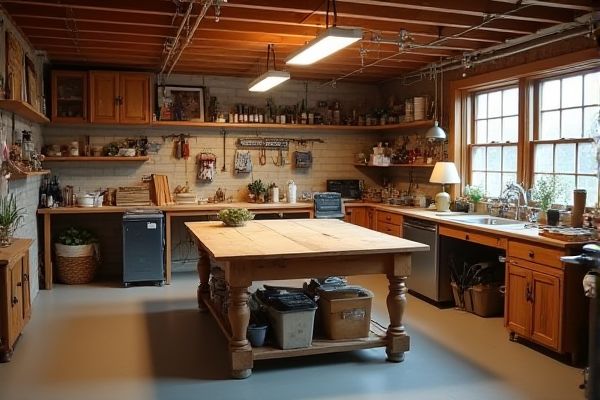
A workbench and a crafting table in a basement setup serve different purposes; a workbench is typically more robust for heavy-duty projects, while a crafting table offers convenience for smaller, detailed crafts. Discover how to optimize Your basement workspace by choosing the right surface for your needs in the rest of this article.
Table of Comparison
| Feature | Workbench | Craft Table Basement |
|---|---|---|
| Primary Use | Basic item crafting and tool repair | Advanced crafting with expanded recipe options |
| Location | Buildable anywhere on surface | Located specifically in basement/workshop area |
| Crafting Grid Size | 3x3 grid | Variable grid, often larger than 3x3 |
| Upgrade Potential | Limited to basic upgrades | Supports upgrades and specialized tools |
| Access to Blueprints | Standard recipes only | Includes rare and complex blueprints |
Introduction: Comparing Workbenches and Craft Tables
Workbenches and craft tables both serve as essential work surfaces in a basement setting, each offering unique features tailored to specific tasks. Workbenches typically provide sturdy construction with integrated storage and tool organization, ideal for heavy-duty projects and precise craftsmanship. Craft tables prioritize spacious, flat areas for creative activities, often featuring adjustable heights and easy-to-clean surfaces suited for arts and crafts.
Purpose: Defining Workbench and Craft Table Functions
The workbench in a basement serves primarily for mechanical repairs and detailed assembly tasks, providing a sturdy surface equipped with tool storage to enhance workflow efficiency. Craft tables are designed specifically for artistic and crafting activities, offering ample space for materials and supplies to enable precision and creativity. Your choice depends on whether the focus is on technical projects or creative crafting, as each table's functions cater to distinct purposes.
Key Features of a Basement Workbench
A basement workbench typically features a sturdy, durable surface made from hardwood or heavy-duty materials designed to withstand heavy use. Integrated storage options such as drawers, shelves, and pegboards enhance organization and accessibility for tools and equipment. Its ergonomic height and ample workspace improve efficiency and comfort during detailed projects or repairs in basement settings.
Craft Table Essentials for Basement Spaces
Craft tables designed for basement spaces optimize your limited area by offering compact, multi-functional surfaces with integrated storage options that keep tools and materials organized. Workbenches typically provide sturdier construction and enhanced durability, suitable for heavy-duty projects but may require more floor space and lighting considerations in a basement setting. Selecting the right craft table ensures efficient use of your basement, balancing workspace comfort with accessibility to essential crafting supplies.
Material and Build Quality Differences
Workbench bases typically feature sturdy metal frames designed for durability and heavy-duty usage, while craft table basements often utilize lighter wood or composite materials that prioritize aesthetics and versatility. Workbench materials are chosen to withstand high impact and wear from tools and machinery, ensuring long-term stability, whereas craft table constructions focus on smooth surfaces and ease of customization for various crafting activities. Your choice should consider whether you need robust structural support or a flexible, visually appealing workspace.
Storage Solutions: Workbench vs Craft Table
Workbench and craft table basements offer distinct storage solutions tailored to different needs. Workbenches typically provide robust storage with built-in drawers, shelves, and pegboards ideal for organizing heavy tools and equipment. Craft tables emphasize open storage with compartments and bins designed for smaller supplies, allowing you easy access to materials during creative projects.
Space Optimization in Basement Setups
Workbench setups in basement workshops maximize space by offering compact, multi-functional surfaces tailored for diverse tasks, optimizing limited room efficiently. Craft tables enhance spatial organization with built-in storage compartments and adjustable work areas, allowing seamless transition between projects without clutter. Both solutions prioritize ergonomic design and vertical storage, significantly improving workflow and accessibility in tight basement environments.
Safety and Ergonomics Considerations
Workbench vs craft table basement setups differ significantly in safety and ergonomics considerations, with workbenches typically offering more robust stability and higher load capacity, reducing risk of accidents from tip-overs or collapsing surfaces. Ergonomically, workbenches are often designed at optimal height to minimize strain on your back and wrists during prolonged tasks, while craft tables may lack adjustable features, potentially leading to discomfort or repetitive stress injuries. Ensuring proper lighting and workspace organization around either station enhances safety and supports healthier body mechanics.
Cost Comparison: Budgeting for Your Basement Workspace
Workbench and craft table basements differ significantly in cost, with workbenches typically requiring a higher initial investment due to their robust materials and specialized features. Craft tables offer a more budget-friendly option, providing versatile surfaces suitable for various projects without the expense of heavy-duty construction. Assessing your workspace needs helps you balance durability and affordability, ensuring your basement setup aligns with your financial plan and project demands.
Choosing the Right Option for Your Basement Projects
Selecting between a workbench and a craft table for your basement projects depends on the type and scale of work you plan to undertake. Workbenches offer sturdy surfaces ideal for heavy-duty tasks like woodworking or mechanical repairs, often including built-in storage for tools and materials to keep your workspace organized. Craft tables, on the other hand, provide versatile, lightweight designs suited for detailed, smaller-scale activities such as sewing, painting, or assembling models, making them perfect for creative projects requiring precision and flexibility.
 homyna.com
homyna.com